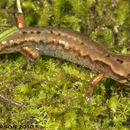en
names in breadcrumbs


Adult male pygmy salamanders produce courtship pheromones only to a desired female. Courtship pheromones are produced in the mental gland of the salamander. Also used in courtship are nasolabial grooves that are located in the snout of the salamander. These nasolabial grooves contain water born chemicals that are sent through nasal passages to the sensory epithelium.
Communication Channels: tactile ; chemical
Other Communication Modes: pheromones ; scent marks
Perception Channels: visual ; tactile ; chemical
Pygmy salamanders are fairly common in spruce-fir forests of the southern Appalachians. These salamander populations are well conserved in Virginia and are listed as a species of least concern.
US Federal List: no special status
CITES: no special status
State of Michigan List: no special status
IUCN Red List of Threatened Species: least concern
After hatching, pygmy salamanders resemble small adults. Gills that were used during the embryonic stage of development are reabsorbed immediately prior to hatching as well as caudal fins. Pygmy salamanders, which are commonly identified by their rounded tail end, are indistinguishable from other species of salamanders in the embryonic stage due to the compressed tail in the egg.
Development - Life Cycle: metamorphosis
Unlike some other species of salamanders, pygmy salamanders do not survive well in captive situations.
Pygmy salamanders are often studied in the wild for their reproductive strategy and reproductive behavior. These salamanders are also researched from an evolutionary standpoint to understand how they live in higher elevations compared to other species of salamanders.
Positive Impacts: research and education
Pygmy salamanders are the most terrestrial species of salamander in the genus Desmognathus. All Desmognathus salamanders have different life cycles, body sizes, and behaviors, and are considered to inhabit different niches. All Desmognathus species are affected by a common leech parasite, Oligobdella biannulata. These leeches, when latched on to the body of a salamander, transfer trypanosome protozoans called trypanosome, which infect the blood stream of the salamander host.
Commensal/Parasitic Species:
Pygmy salamanders primarily feed at night on small arthropods in the soil and leaf litter.
Animal Foods: insects; terrestrial non-insect arthropods
Primary Diet: carnivore (Insectivore , Eats non-insect arthropods)
Pygmy salamanders can be found in mountainous areas ranging from the Blue Ridge Mountains to the Great Smoky Mountains in the eastern United States. They are found most frequently in southwestern Virginia to the Georgia state line in southwestern North Carolina.
Biogeographic Regions: nearctic (Native )
Pygmy salamanders are found in humid forested areas and can be found under mosses and rotten logs. Dense populations of pygmy salamanders occur most often in highly elevated spruce-fir forests, but also occur in hardwood forests in lower elevations. Elevations range from 800 m to 4500 m.
Range elevation: 800 to 4500 m.
Habitat Regions: temperate ; terrestrial
Terrestrial Biomes: forest ; mountains
Although there is not any data on longevity of pygmy salamanders, other salamanders in the Desmognathus range in longevity from 15 to 20 years in captivity.
Adult pygmy salamanders range in size from 30 to 51 mm. They can primarily be identified by their distinctive coppery red stripe that extends along the body to the rounded tail. The rounded tail is less than half of total body length. The eyelids are also a copper color, which is a trait that distinguishes pygmy salamanders from related species. At sexual maturity females tend to be larger than males.
Range length: 30 to 51 mm.
Other Physical Features: ectothermic ; heterothermic ; bilateral symmetry
Sexual Dimorphism: female larger
Spring salamanders (Gyrinophilus porphyriticus) and carabid beetles are major predators of pygmy salamander. Pygmy salamanders become immobile when threatened, becoming less appealing to predators. Pygmy salamanders are cryptically colored and tend to spend much of their time under cover to avoid detection.
Known Predators:
Anti-predator Adaptations: cryptic
Mating occurs twice a year during the fall and spring months. Adult male pygmy salamanders produce courtship pheromones to a desired female. In order for a male to mate with a female, the male salamander must use his jaws to attach himself to a female’s tail. This ritual is primary done to restrain the female and keep her from finding another mate.
Mating System: monogamous
Male pygmy salamanders deposit a spermatophore (a gelatinous package including sperm) on the ground, after which the female will take it into her cloaca. Females typically deposit eggs in a cluster during the late summer. Ideally, females deposit their eggs close to a permanent body of water, either a lake or a stream, but at higher elevations where standing water is absent, female salamanders lay their eggs on moist ground. Females lay an average of 10 eggs. Hatching usually occurs in mid to late October. Once hatched, the young are immediately independent and reach sexual maturity at 3.5 years for females and 4.5 years for males.
Breeding interval: Breeding can occur twice yearly.
Breeding season: Pygmy salamanders breed in the late fall and late spring months.
Range number of offspring: 5 to 10.
Average time to hatching: 2 months.
Average age at sexual or reproductive maturity (female): 4.5 years.
Average age at sexual or reproductive maturity (male): 3.5 years.
Key Reproductive Features: iteroparous ; seasonal breeding ; gonochoric/gonochoristic/dioecious (sexes separate); sexual ; fertilization (Internal ); oviparous
Male pygmy salamanders do not play any role in helping with their young. However, females tend to eggs and to newly hatched salamanders.
Parental Investment: female parental care ; pre-fertilization (Provisioning, Protecting: Male); pre-hatching/birth (Provisioning: Female, Protecting: Female)